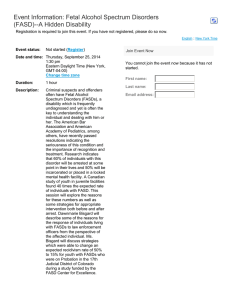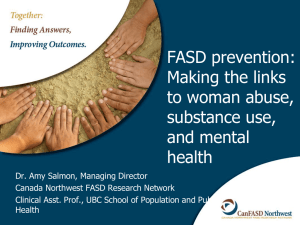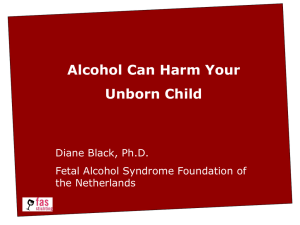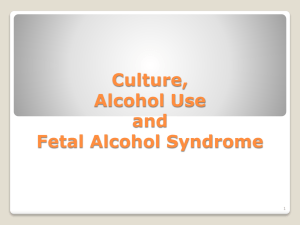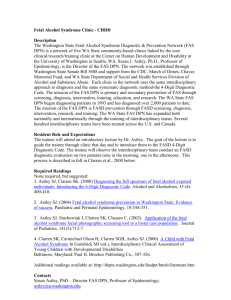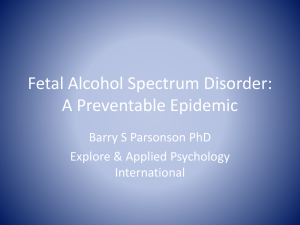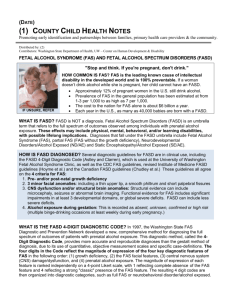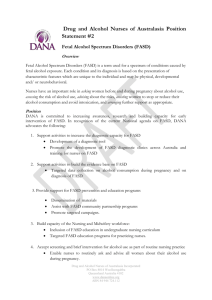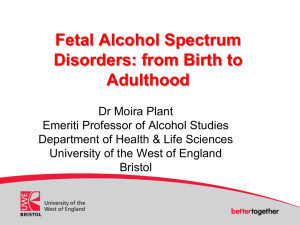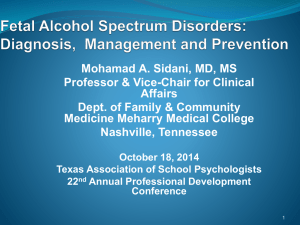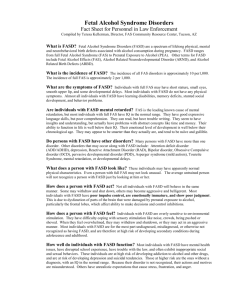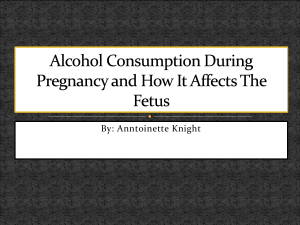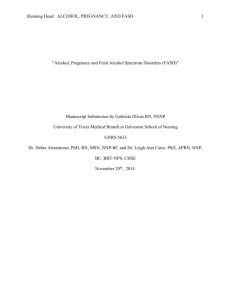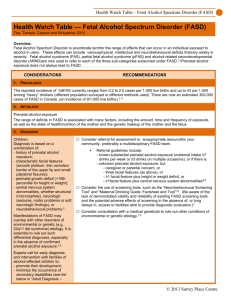Fetal Alcohol Spectrum Disorder - Contemporary Practices in Early
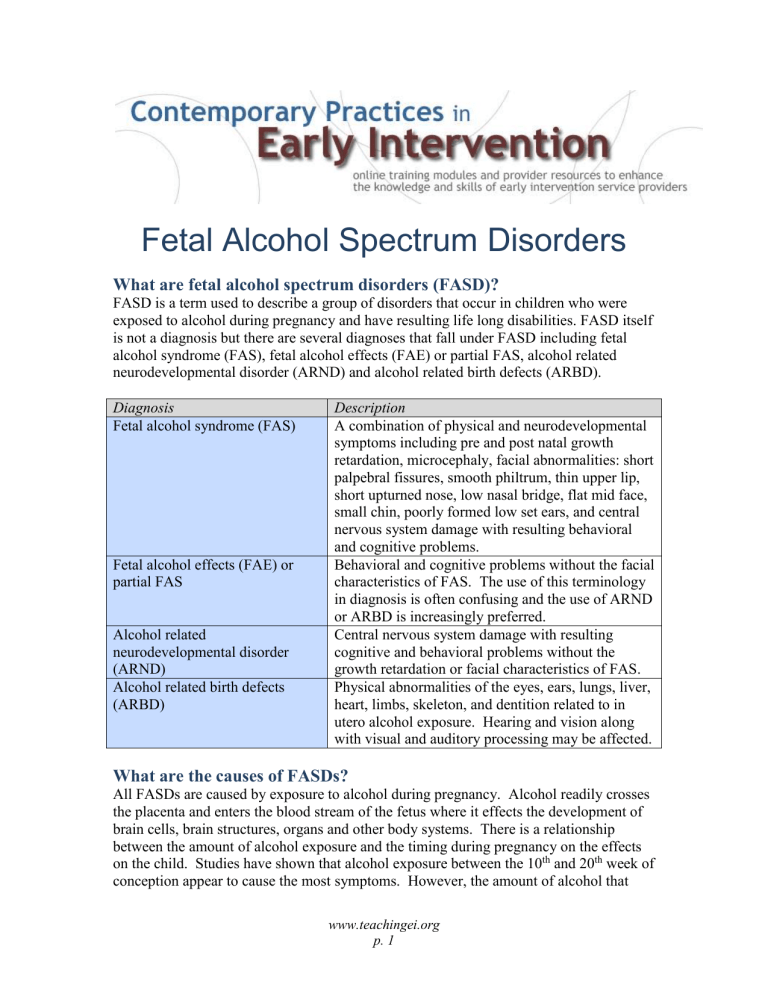
Fetal Alcohol Spectrum Disorders
What are fetal alcohol spectrum disorders (FASD)?
FASD is a term used to describe a group of disorders that occur in children who were exposed to alcohol during pregnancy and have resulting life long disabilities. FASD itself is not a diagnosis but there are several diagnoses that fall under FASD including fetal alcohol syndrome (FAS), fetal alcohol effects (FAE) or partial FAS, alcohol related neurodevelopmental disorder (ARND) and alcohol related birth defects (ARBD).
Diagnosis Description
Fetal alcohol syndrome (FAS)
Fetal alcohol effects (FAE) or partial FAS
Alcohol related neurodevelopmental disorder
(ARND)
Alcohol related birth defects
(ARBD)
A combination of physical and neurodevelopmental symptoms including pre and post natal growth retardation, microcephaly, facial abnormalities: short palpebral fissures, smooth philtrum, thin upper lip, short upturned nose, low nasal bridge, flat mid face, small chin, poorly formed low set ears, and central nervous system damage with resulting behavioral and cognitive problems.
Behavioral and cognitive problems without the facial characteristics of FAS. The use of this terminology in diagnosis is often confusing and the use of ARND or ARBD is increasingly preferred.
Central nervous system damage with resulting cognitive and behavioral problems without the growth retardation or facial characteristics of FAS.
Physical abnormalities of the eyes, ears, lungs, liver, heart, limbs, skeleton, and dentition related to in utero alcohol exposure. Hearing and vision along with visual and auditory processing may be affected.
What are the causes of FASDs?
All FASDs are caused by exposure to alcohol during pregnancy. Alcohol readily crosses the placenta and enters the blood stream of the fetus where it effects the development of brain cells, brain structures, organs and other body systems. There is a relationship between the amount of alcohol exposure and the timing during pregnancy on the effects on the child. Studies have shown that alcohol exposure between the 10 th
and 20 th
week of conception appear to cause the most symptoms. However, the amount of alcohol that www.teachingei.org
p. 1
causes certain types of symptoms or the severity of those symptoms varies widely and is dependent on individual factors in the mother and the child. Some children can be affected by a relatively small exposure and others have very little effect from larger doses. Therefore, there is no known safe level of alcohol consumption during any part of pregnancy. (See Effects of Alcohol on a Fetus at http://www.fascenter.samhsa.gov/documents/WYNK_Effects_Fetus.pdf
)
How many children have FASDs?
FASDs are a leading cause of developmental disabilities with an incidence as much as twice the rate of Down syndrome. The US Department of Health and Human Services reports that although there have been many efforts to inform women about the dangers of alcohol consumption during pregnancy, 12% of women still drink while pregnant and 1 in 8 babies are exposed to alcohol in utero each year and are at risk for an FASD.
Estimates are that one percent or over 40,000 babies in the United States are born each year with an FASD. The incidence for each separate diagnosis under the FASD umbrella is not known and estimates vary. According to the Center for Disease Control and
Prevention, estimates of FAS vary from 0.2 to 1.5 in 1,000 live births. The incidence of
FAS, ARND and ARBD combined is three times the rate of FAS alone.
Children from low income, ethnic minorities have higher rates of FASDs. Hispanic,
Asian and white populations all have similar rates of FASDs. Native Americans have the highest rates followed by African Americans. Regional differences in rates of FASDs in
Native American populations exist and there is wide tribal diversity across North
America. The estimate in 1999 for the rate of FASDs in Alaska was 16 per 1,000 live births. Estimates in the 1980’s among Native American populations ranged from 29.9 in
10,000 live births to 39 to 333 per 10,000 live births in Southwestern Native American tribes.
Effects of alcohol on development
Alcohol exposure can permanently impact the development of most of the body systems including the central nervous system, face, sensory systems, organs and bones. The effect on the central nervous system and sensory systems include problems with thinking, learning, behavior, social skills, daily living activities and the ability to work and live independently. The effects of FASDs in young children include
Cognition and learning problems
intellectual disability
learning disabilities
inattention
memory problems
reasoning and judgment difficulties
mathematical difficulties difficulties with concepts of time-space and cause-and-effect
speech and language delays
sensory processing disorders www.teachingei.org
p. 2
Physical development problems
growth retardation
facial abnormalities
organ abnormalities (lung, heart, liver)
limb reductions
Behavior and social-emotional problems
delays and disabilities in adaptive and daily living skills
hyperactivity
poor impulse control
dental problems
vision and hearing problems
sleep disturbances
motor skill delays
behavior disorders
poor social skills
anxiety and depression
Importance of Early intervention and FASDs
Early intervention providers should be aware that studies indicate that early intervention services can minimize the negative effects of FASDs. Early intervention is most effective in reducing secondary disabilities in the areas of mental health, social development, behavior, motor and adaptive or independent daily living skills. Children who have received early intervention services and supports have shown fewer problems with attention, learning, and language development.
Further, teaching strategies that focus on structured routines with simple instructions and incorporate hands-on learning experiences with repetition are helpful for children with
FASDs who have difficulty with receiving, storing and using new information.
An understanding of the life long disabilities an FASD can cause is important for planning early intervention and preschool programming. Not a Single Drop from the
Ohio Resource Network for Safe & Drug Free Schools & Communities provides a helpful breakdown of life stages, what problems and concerns to expect and recommendations to approach services and supports for families who have children with an FASD ( http://www.notasingledrop.org/fasd/what-is-fasd/fact-sheets/fasd-overview ). www.teachingei.org
p. 3
Age
Infancy &
Early
Childhood
(0-5)
Latency
Period (6-11)
Problems and Concerns
Sleep disturbances
Poor sucking responses
Failure to thrive
Delays in developmental
milestones
Delayed toilet training
Difficulty following
directions
Difficulty regulating moods
& emotions
Temper tantrums
Distractibility and hyperactivity
Poor adaptation to sensory stimuli
Easily influenced and difficulty predicting and/or understanding consequences
Give an appearance of capability without actual abilities
Difficulty separating fact from fantasy
Temper tantrums, lying, stealing, disobedience and defiance of authority
Delayed physical and cognitive development
Poor comprehension of social rules and expectations
Recommendations
Early identification/ intervention with
birth and/or foster/adoptive parents
Education of parents regarding physical and psychosocial needs of an infant or child affected by FASD
Careful monitoring of physical, social and emotional development and health
Safe, stable and structured home
Assignment of a service coordinator
Appropriate preschool or educational environment
Respite care for caretakers
Safe, stable and structured home
Careful and continued monitoring of
health issues and existing problems
Appropriate educational environment with regular assessments
Establish expectations and goals for future
Support group
Use of clear, concrete and immediate consequences for behavior
Respite care for caretakers
Service coordinator or advocate role expands to include liaison between parents, school, health care providers, and social service agents.
Adolescence
(12-17)
Lying, stealing and passivity
in responding to requests
Faulty logic
Egocentric: difficulty comprehending and/or responding appropriately to other people’s feelings, needs and desires
Low motivation and self esteem, depression
Academic ceiling which is usually around grade 4 for reading and grade 3 for
Spelling and Math
Pregnancy or fathering a child
Consider transition to supervised or independent
Education of caregivers and adolescents regarding sexual development, birth control options and protection from sexually transmitted diseases
Planning and implementation of transition to appropriate educational, adult residential or vocational training
Mental health services and supports as needed
Respite care for caretakers
Support group
Safe, stable and structured home or residential placement
Careful monitoring of social activities and structuring of leisure time
Working towards increased independence with appropriate instruction in making www.teachingei.org
p. 4
Adulthood
(18 and beyond) living healthy choices
Supervised or independent living
Economic support and protection
Job training and placement
Depression and suicidal
ideation
Pregnancy or fathering of a
child
Social and sexual exploitation, or inappropriate
behavior
Increased expectations of the person affected by FASD by
other people
Increased dissatisfaction towards the person affected
by FASD by others
Withdrawal and isolation
Unpredictable behavior
Guardianship for funds
Specialized residential and/or subsidized living
Specialized vocational training and job placements
Medical coupons
Acceptance of the person’s “world”
Acknowledgment of the person‘s skills
and limitations
Advocates to ensure the above occurs
References
Abel, E. (1995). An update on incidence of FAS: FAS is not an equal opportunity birth defect. Neurotoxicology and Teratology . 17 (4), 437-443.
American Academy of Pediatrics (2000) Fetal alcohol syndrome and alcohol-related neurodevelopmental disorders policy statement. Pediatrics . 106 (2), 358-361. Available at http://aappolicy.aappublications.org/policy_statement/index.dtl#F
Learning about learning disabilities and health: Fetal alcohol syndrome, an overview http://www.intellectualdisability.info/mental_phys_health/fetal_alcohol_mukherjee.htm
Lupton, C.; Burd, L.; and Harwood R. 2004. Cost of fetal alcohol spectrum disorders.
American Journal of Medical Genetics. 127C(676), 42-50.
National Center for Continuing Education: Fetal Alcohol Syndrome http://www.nursece.com/onlinecourses/9012.html
National Organization on Fetal Alcohol Syndrome. FASD: What School Systems Should
Know About Affected Students. Available at http://www.nofas.org/MediaFiles/PDFs/factsheets/students%20school.pdf
Resources
Call to Action: Advancing Essential Services and Research on FASD http://www.cdc.gov/ncbddd/fas/documents/08_121973CallActionBk+Cov.pdf
www.teachingei.org
p. 5
Fetal Alcohol Spectrum Disorders Center http://www.fascenter.samhsa.gov/index.cfm
FAS Diagnostic and Prevention Network http://depts.washington.edu/fasdpn/index.htm
FASD Competency-Based Curriculum Development Guide for Medical and Allied
Health Education and Practice http://www.cdc.gov/ncbddd/fas/curriculum/index.htm
National Organization on Fetal Alcohol Syndrome http://www.nofas.org/
Native Initiative http://fascenter.samhsa.gov/nativeinitiative/index.cfm
Not a Single Drop http://www.notasingledrop.org/fasd/what-is-fasd/fact-sheets/fasd-overview
Substance Abuse and Mental Health Services Administration’s (SAMHSA) FASD
Center for Excellence http://fascenter.samhsa.gov/
State of Alaska Office of Fetal Alcohol Syndrome http://hss.state.ak.us/fas/
Cite as: Georgetown University Center for Child and Human Development.
Contemporary Practices in Early Intervention: Fetal Alcohol Spectrum Disorder
Primer. 2011. Available online at http://www.teachingei.org.
www.teachingei.org
p. 6
